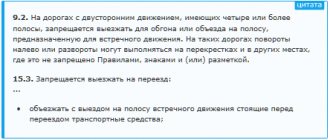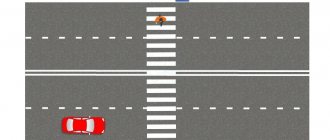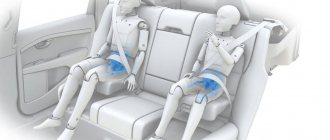The traffic rules provide for overtaking across a continuous road, a fine for performing such a maneuver, or, as an alternative, deprivation of the ability to drive a vehicle. The driver must be aware of this violation.
Such a violation has its own nuances; the rules indicate situations when travel is not prohibited according to this principle. But in general, such a maneuver is considered solely as potentially dangerous. And such a trip is especially fraught with problems where several categorical points of the rules “intersect” on one section of the road.
What is the penalty for overtaking under the new rules in 2021?
The total number of prohibitions in traffic regulations regarding overtaking is several dozen. This includes a sign prohibiting entry into the oncoming lane, solid lines and many other conditions.
However, the punishment in the current Code of Administrative Offenses of the Russian Federation is listed for one action that unites all such cases - for driving into oncoming traffic in violation of the Rules. That is, it does not matter which particular point of the traffic rules you violated - if this legal act specifically prohibits driving into the oncoming lane on a given section of the road, then the punishment is the same. To be more precise, there are several of them, however, they have a common specified cause of violation.
That is, you need to understand the following. Overtaking, being an independent maneuver, includes 3 others: changing lanes into the oncoming lane, getting ahead, and then changing lanes again into the previously occupied lane. So, the punishment is imposed precisely for the very fact of driving into oncoming traffic - for one of the components of overtaking maneuvers.
Let's take a look at all the liability measures for this!
Table of fines and deprivation of rights for overtaking
| Article of the Administrative Code | What is the punishment for? | What is the punishment? |
| 12.15, part 4 | Driving into oncoming traffic, including prohibited overtaking, except for the case provided for in Part 3 of the same article (see below). | Fine 5,000 rubles or deprivation of rights for 4-6 months |
| 12.15, part 5 | Repeated violation, when under Part 4 you have already been fined or imprisoned over the last year (we will talk about the intricacies of repetition below) | Deprivation of rights for 1 year or a fine if you were recorded by a photo or video camera |
| 12.15, part 3 | Drifting into the oncoming lane when avoiding an obstacle | Fine from 1 to 1.5 thousand rubles |
What does repeat violation mean?
The Administrative Code provides for the imposition of more severe sanctions if the driver has committed a repeat offense for a specific violation. This issue is regulated by Article 4.6 of the Administrative Code, and we are talking about the sequence of the terms themselves in administrative law:
- repetition itself is possible only when the driver is considered to have been punished,
- in 4.6, the period of such exposure is calculated from the date of entry into force of the decision on a fine or imprisonment for overtaking and within 1 year after full execution of the punishment for the first violation,
- and execution is full payment of the traffic police fine or the end of the period of deprivation of the right to drive.
Thus, if you are caught for prohibited overtaking for the second, third, and so on times, then you will be given a more severe punishment if the first decision has entered into force (the 10-day period for appeal has passed, and you did not file a complaint) and 1 year has not passed from the date of full payment of the fine or from the date of the end of the deprivation period.
Here's a simple example.
The first time the driver was caught for overtaking through a double solid road was on June 20 last year. The decision was made on June 30, where the driver was deprived of his license for 4 months, and he did not challenge this sanction. In this case, if a motorist is caught for the second time with a violation, liability for which is qualified under Part 4 of Article 12.15 of the Code of Administrative Offenses of the Russian Federation, in the period up to November 11, 2021 inclusive, then he will already be given a punishment under Part 5 of this article with deprivation of rights for 1 year (if caught on camera, there will be a fine of 5 thousand).
What did we think here? The resolution came into force on July 10 last year (the appeal period is 10 days) and the period of punishment began from this date. This period ends within a year after the execution of the sentence. And it was executed on November 10 last year (4 months of deprivation of rights). That is, for another year after this, the driver is considered liable.
If in this example the driver had been given a fine, which he would have paid in full on July 2, then until July 3, 2021, a more severe punishment could have been imposed for repeated prohibited overtaking.
You will also be interested in:
- What is the penalty for making a U-turn at a pedestrian crossing and when is it prohibited by traffic regulations?
- Who has the advantage when driving and changing lanes in the acceleration lane? Overtaking and getting ahead
- Where and how is stopping allowed according to traffic rules? Signs, road sections and distances
Who assigns responsibility?
Either a traffic police inspector is in charge, or a judge. Here everything happens in the following sequence:
- A traffic police officer on the road stops a driver for violating overtaking (for example, at a pedestrian crossing) and initiates a case by drawing up a protocol, where the driver has the right to make notes,
- then this protocol is transferred to the chief of this inspector, who sets the date and time of the analysis and invites the driver to testify, based on the results of which he decides whether to impose a fine or deprivation on the driver,
- if the driver, by decision of the head of the traffic police, is “honored” of a fine, then a resolution with it is issued immediately, but if the traffic police officer decides that the case is worthy of deprivation of rights, then the material is transferred to the magistrate’s court according to the territoriality of the violation, since the inspector does not have the right to deprive rights on his own rights (Article 23.1 of the Administrative Code),
- Then the judge decides again - maybe still impose a fine, or there are aggravating circumstances, and the driver will have to travel for a long time on foot, by taxi, public transport or car sharing.
Is there a discount on the fine?
Yes, if you are caught for the first time, you will be charged under Part 4 of Article 12.15 of the Code of Administrative Offenses of the Russian Federation. How much are you entitled to pay in this case? The fine in this case is 2,500 rubles. But please note that the deadline for this is 20 days from the date the resolution was issued (not to be confused with the date it entered into force).
But if you are charged under Part 5 for repeated overtaking, then the discount is no longer valid. This is what Part 1.3 of Article 32.2 of the Code of Administrative Offenses says.
How to defend your case to the driver
If an offense is recorded by a traffic police officer, then the driver, before starting to explain the fact of his violation, needs to find out exactly how the recording was carried out. If a photo or video was taken, the inspector is obliged to inform the driver of the fact of the violation. In this case, there is no chance of success in evading the fine.
In a situation where there is no record of an offense, the driver must demand to see the fact of the violation on his part. In this case, the inspector must provide testimony from at least 2 witnesses to the driver violating the rules.
Dear reader! Didn't receive an answer to your question? Our expert lawyers work for you. It's absolutely free!
- Moscow ext 152
- St. Petersburg ext 152
- All regions ext 132 (Toll free)
In turn, if there are passengers in the car, then their testimony, which does not confirm the violation, can also be included in the case.
In this case, the case will be taken to court and there the driver will have to defend his truth, providing evidence in contrast to the evidence presented by the traffic police inspector. Overtaking on a continuous road fine Penalties for overtaking on a continuous road
Will I be given a deprivation or a fine?
This depends on a number of factors, and this issue is regulated by the same Administrative Code. Although, there are other conditionally unwritten conditions for assigning one or another sanction.
- First, to receive a fine, you must have the maximum number of mitigating conditions for a given violation.
- Secondly, there should be no aggravating factors, such as repeated violation, state of intoxication and others.
- Thirdly, you should not have any fines for the last year, not unpaid, but in general. This comes from subparagraph 2 of paragraph 1 of Article 4.3 of the Code, which refers to the presence of homogeneous violations as an aggravating circumstance. Alas, almost all drivers in Russia do not meet this condition. And this was decided by the Supreme Court, which indicated that the homogeneity of the offense applies to all road traffic - that is, the presence of any decisions over the last year is considered an aggravating factor.
Appeal
You must file a complaint with the agency that issued the fine. It is considered within a maximum of 10 working days (Article 30.5 of the Administrative Code).
A fine drawn up and assigned by the State Traffic Inspectorate can be challenged in several ways:
- online – write a complaint on the traffic police website;
- in person (contact the department of the State Traffic Inspectorate that issued the decision);
- send your appeal by mail.
You also have the right to go to court at the location of the traffic police department or the driver’s place of residence.
By the way, if a fine for driving into oncoming traffic was paid, and then a decision was made about illegality and cancellation, you can get the money back. To do this, you need to submit an application, attaching a package of documents:
- copy of passport;
- bank account details;
- documents confirming the payment;
- decision to cancel the fine (instead of the original, it can be a copy).
Applications to appeal a fine for driving into the oncoming lane can be found here.
Where is it prohibited to overtake according to traffic rules and what is the responsibility?
So, we have come to the most extensive question of our topic. As we said above, there are a lot of conditions for prohibiting entry into the oncoming lane, and many of them sometimes have a fine line between permitted and prohibited overtaking.
But first of all, let's talk about the very concept of this term!
Overtaking or not?
This maneuver itself consists of 3 other maneuvers:
- changing lanes into oncoming traffic,
- directly ahead of the overtaken vehicle,
- returning to your lane in front of the overtaken person.
The very definition of the term “Overtaking” in paragraph 1.2 of the Rules speaks about the oncoming lane. Thus, changing lanes in the same direction and then overtaking is not considered overtaking, and therefore a fine or deprivation of rights is in no way applicable in this case. Likewise, advancing on the right or along the right shoulder cannot fall under this term.
We will return to these questions below.
Through a continuous line with an intersection
At the very beginning of the article, it was not for nothing that we talked about responsibility not specifically for overtaking as a whole set of 3 maneuvers, but specifically for the main one - moving in the opposite direction in cases where this is prohibited by traffic rules.
This is true, because in this case the Rules do not directly prohibit overtaking through a continuous lane. They prohibit crossing it - this is what clause 9.1(1) introduced after recent changes to the traffic rules says. But even before the introduction of new rules, drivers were still subject to fines and imprisonment. It’s just that the prohibition was not clearly stated in the Rules.
Expert opinion
Yuri Panchenko
Driving instructor, human rights activist, author of books. 10 years of experience.
When considering issues related to driving into oncoming traffic, it is important to know:
- Departure continues from the moment any part of the car appears in the oncoming lane until the moment the car completely leaves the oncoming lane. That is, departure is a long-term action. This is the opinion of the Constitutional Court.
- All cases of driving into oncoming traffic are considered in the Resolution of the Plenum of the Supreme Court No. 18 dated June 25, 2019. This includes all the cases described in the article.
I would like to draw your attention to one subtlety. If you turn left into the yard through a double solid lane, then the punishment under Part 1 of Article 12.16 of the Code of Administrative Offenses with a fine of 500 rubles. But if you leave the yard to the left through a double solid lane and after turning you find yourself in the extreme left lane, then the punishment is under Part 4 of Article 12.15 of the Administrative Code with a fine of 5,000 rubles or deprivation of the right to drive for a period of 4 to 6 months.
Ask a Question
If there was a double solid?
Please note that the above paragraph does not only refer to a single solid line marking which will result in a penalty for overtaking. This includes 2 more types of markup:
- 1.3 – double solid line (it separates oncoming traffic on roads with 4 or more lanes),
- 1.11 - solid with a dotted line, which prohibits crossing it only on one side - in this case, on your side.
What if you can’t see the solid one?
According to the Federal Law on Road Safety, responsibility for road maintenance falls on the state. At the same time, in order to ensure liability for such content, there is also a separate measure of liability for its violations.
Consequently, if the driver violated the marking requirement and crossed a solid line (including a double line) to overtake, then there should not be a fine for this, because it is not his fault. It is the fault of the authority responsible for this section of the road.
But this state of affairs is applicable only if the traffic police officer or judge examining the case does not know (including from the motorist himself) that the driver knew about the presence of a continuous road when overtaking or suspected its existence in a given place.
Is it possible to finish by crossing a solid line if you started through a broken line?
No. This is prohibited, and this is exactly how judicial practice works in 2021 for crossing a solid line when overtaking.
The fact is that the courts here do not at all recognize the absence of the driver’s guilt in the fact that he did not foresee the beginning of the solid line (since he did not notice the “Overtaking is prohibited” sign) for one reason or another.
But, again, it all depends on the specific circumstances of the case. For example, if the dashed line before the solid one did not first turn into a long dashed line, warning about the imminent start of the continuous marking (1.6), then the deprivation of license or the fine for overtaking has every chance of being cancelled, since the driver could not have foreseen the sudden appearance of line 1.1 or 1.3.
Subtlety with a continuous road without entering the oncoming lane
As we already wrote above, a fine is issued or a deprivation is assigned at 12.15 in the case of specifically driving into the oncoming direction of traffic. But what is the threat and what will be the amount of the fine if we are talking about crossing a continuous line while overtaking without oncoming traffic? Or if the plot unfolds on a one-way road.
Here, as we found out, the term “overtaking” is not applicable at all, since it is associated only with the oncoming lane.
In this case, marking 1.1 divides the lanes into passing directions. Namely, a continuous one was applied, because this is considered a dangerous section of the road. For example, a sharp turn or approaching an intersection.
And in this case, the fine will be much lower - 10 times than for crossing a solid marking line when overtaking, where the oncoming lane is located. Its amount is 500 rubles under Part 1 of Article 12.16 for violation of markings. It can also be paid with a 50% discount.
And according to the legislation of 2021, there should be no deprivation here.
Something else useful for you:
- How to drive through a roundabout intersection correctly according to the new rules? Sequence, stripes and signs
- What are the rules for road humps? Dimensions, installation and penalties
- Traffic regulations about passing a stationary car on a continuous road: what is the fine and is it possible to cross?
Under the “No Overtaking” sign
And again we return to the punishment specifically for driving into the oncoming lane. It does not matter which specific clause of the Rules prohibited overtaking - a sign, continuous markings or the presence of a pedestrian crossing. In any case, the punishment will follow precisely for prohibited driving into the oncoming lane. And it is the same - a fine of 5,000 rubles or imprisonment for a period of 4 to six months under Part 4 of Article 12.15 of the Administrative Code.
What if the sign wasn't visible?
Similar to snow-covered, dirty or erased solid markings, the absence of a “No Overtaking” sign, of course, entails the illegality of a fine or deprivation. But wait, why are we talking about the absence of a road sign?! After all, it is there, we just didn’t notice it - for example, when overtaking a long truck on the highway.
The thing is that GOST, which regulates the rules for installing road structures, has recently undergone changes. So, according to the new rules for installing signs - clause 5.1.6 of GOST R52289-2019, sign 3.20 Overtaking is prohibited must be duplicated on the left so that it is visible to all road users.
And we return to measures of responsibility. If 3.20 is not on the left, then, indeed, you are not subject to punishment, and the decision should be canceled. Moreover, in this case, the judge hearing the case is obliged to issue an order to the road services to eliminate this defect.
Of course, all of the above takes place only if in this section entering the oncoming lane was prohibited only by a sign. If there was a continuous marking visible to the eye, then, alas, it will not be possible to challenge the deprivation of rights on this basis.
What if the road sign is temporary?
It doesn’t matter whether the “No Overtaking” sign is permanent or temporary – the penalties for it are the same.
At a pedestrian crossing
Overtaking is prohibited. This is expressly stated in paragraph 11.4 of the traffic rules. At the same time, before crossings there should always be a continuous marking line separating oncoming traffic.
Please note that you can get ahead of other cars (that is, without entering oncoming traffic) only taking into account clause 14.2 - if another car has stopped or slowed down in front of a pedestrian crossing, then you must do this too.
At the crossroads
There are 2 important conditions when overtaking at intersections is allowed:
- if it is unregulated by traffic lights,
- if you are driving along the main road of an unequal intersection.
This is regulated by paragraph 11.4 of the traffic rules.
In all other cases, overtaking is prohibited.
When turning
Moreover, please note that even if the main road turns right or left, there is nothing that would prohibit you from overtaking straight ahead. However, when turning left, keep in mind the presence of paragraph 8.6 of the Rules, which indicates to press as far to the right as possible when turning right.
In addition, if, for example, the main road turns, and you need to go straight, then nothing here prohibits you from overtaking, since the intersection itself includes the main road along which you are moving - that is, you find yourself on a secondary road already at the exit from the intersection.
Double overtaking in a column
It is also forbidden to overtake another car, as this maneuver is also called a “locomotive”. Thus, clause 11.2 literally prescribes the following:
- overtaking is prohibited if the car in front has started it,
- it is also prohibited if someone from behind has entered the oncoming lane,
- and the third case - if the car ahead turns on the left turn signal.
At the railway crossing
Overtaking is prohibited on 2 sections of the road (clause 11.4):
- at the railway crossing itself,
- 100 meters in front of him.
Please note that there are also usually continuous markings at a sufficient distance to the crossing.
Moreover, the Code of Administrative Offenses of the Russian Federation has a separate article for all violations at crossings - 12.10. However, here Part 4 of Article 12.15 with deprivation or a fine will still apply, since this is a more special standard of liability specifically for overtaking at a railway crossing.
On right
In general, there is no such thing as overtaking on the right if you are in Russia, where right-hand traffic is organized.
As we have already indicated above, overtaking is certainly associated with driving into the oncoming lane. It cannot be on the right. And here, the maximum you can face is a fine of 500 rubles for a solid line separating passing lanes.
On the side of the road
...Well, or the amount of the fine increases to 1,500 rubles if you are ahead of a vehicle on the side of the road. You will be charged under Part 1 of Article 12.15 of the Code of Administrative Offenses of the Russian Federation.
We also have a special article about overtaking another car on the oncoming side of the road.
Overtaking a tram
There are nuances here too. Firstly, a tram cannot be overtaken under any circumstances, because you cannot move on oncoming tram tracks. But you can travel along tram tracks in the same direction, and also under 2 conditions:
- if they are located to your left,
- if they are not completely separated,
- if they are at the same height as the roadway (clause 9.6 of the traffic rules).
Overtaking while crossing a continuous line
Single or double continuous markings running along the center line of the roadway should be perceived by drivers as a wall. It cannot be crossed, since if the rule is violated, the vehicle ends up in the lane of oncoming traffic.
Such maneuvers are fraught with accidents, including fatal ones. This rule applies to markings of any color.
Overtaking while crossing a solid road is permitted in the following cases:
- performing the maneuver will cause less damage than refusing it - in particular, if necessary, move to the side to avoid a collision with an inappropriate motorist;
- there is a question about saving a person’s life - for example, he needs to be urgently taken to the hospital;
- A situation has arisen in which overtaking while crossing a solid road is the only way to avoid an accident.
These factors may be considered mitigating circumstances. In such cases, the fine for driving on a continuous road, as well as crossing it, can be minimized or canceled. Against this background, deprivation of rights is usually replaced by a monetary penalty. True, the driver will have to try to prove that he is right and that the situation is hopeless.
Summary table: when will there be a fine or imprisonment for overtaking?
So, let's now look at all types of violations (or situations without them), and what punishment will be applied in a given case.
Table of penalties for overtaking
| Road situation or maneuver | It is allowed? | Punishment |
| “Overtaking” without entering the oncoming lane | Allowed | There is no responsibility, since this is not overtaking at all |
| "Overtaking" on the right on the road | Allowed if there is no solid | No punishment. If it was continuous, then a fine of 500 rubles under Part 1 of Art. 12.16 Code of Administrative Offenses of the Russian Federation |
| “Overtaking” on the passing side of the road | Forbidden | Fine 1,500 rubles under Part 1 of Article 12.15 |
| At a pedestrian crossing | Forbidden | Fine 5,000 rubles or deprivation of rights from 4 to 6 months under Part 4 of Art. 12.15 |
| Through a continuous marking line | Forbidden | Also 12.15, part 4 |
| Through double solid | Forbidden | Article 12.15, part 4 |
| Under the “No Overtaking” sign | Forbidden | Article 12.15, part 4 |
| At the crossroads | Conditionally allowed | Only at unequal uncontrolled intersections and if you are driving on the main road. Otherwise again part 4 of Art. 12.15 with a fine or deprivation of rights |
| Column | Forbidden | Article 12.15, part 4 |
| At the railway crossing | Forbidden | Article 12.15, part 4 |
| On bridges (as well as overpasses and overpasses (interchanges) | Forbidden | Article 12.15, part 4 |
| In the tunnel | Forbidden | Article 12.15, part 4 |
| At the end of a climb, in sharp turns and anywhere where visibility of the road is limited | Conditionally prohibited | Article 12.15, part 4, but the applicability of this norm is controversial, since the sections of the end of the climb and the criteria for sharp turns and limited visibility are not indicated in the 2021 legislation |
| If there are 4 or more lanes on the road | Forbidden | Article 12.15, part 4 |
| If there are no markings on the road at all | Conditionally allowed | No penalty unless it's a 4 lane or more road |
| Overtaking on tram tracks | Conditionally allowed | There is no liability if you are driving along passing tram tracks; they are not separated by a continuous line and are at the same level as the roadway |
| Overtaking a tram | Forbidden | Article 12.15, part 4 |
Avoiding an accident through a solid marking line
Sometimes cars involved in a traffic accident remain on the road. These vehicles are classified as an obstacle by the current legislation of the Russian Federation. This term also refers to any object on the inverter that interferes with normal movement.
A damaged vehicle must be driven around like any obstacle: in accordance with traffic regulations. If a motorist crosses a solid line to avoid an obstacle, he will be held accountable in accordance with Part 3 of Article 12.15 of the Code of Administrative Offenses. The amount of the fine in such cases will vary from 1000 to 1500 rubles.
The driver overtook a vehicle moving at low speed
Not only cars and trucks, but also tractors, dump trucks, horse-drawn carts, etc. can take part in traffic on public roads. Therefore, driving around them through single markings is equated to a prohibited action, for which, according to the law, a fine or confiscation of rights is applied.
Important point! If a vehicle moving at low speed has a “Slow Moving Vehicle” sign, then you can go around it. The traffic police will not apply penalties for this.











